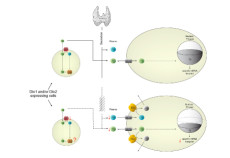
Reawakened interest for type 3 deiodinase during illness.
Thyroid hormones influence gene expression in virtually all vertebrate tissues. Precise regulation of the active endogenous ligand, 3,5,3′- triiodothyronine (T3), is achieved by the sequential removal of iodine moieties from the thyroid hormone molecule. Type III iodothyronine deiodinase (D3) is the major inactivating enzyme terminating the action of T3 and preventing activation of the prohormone, […]
